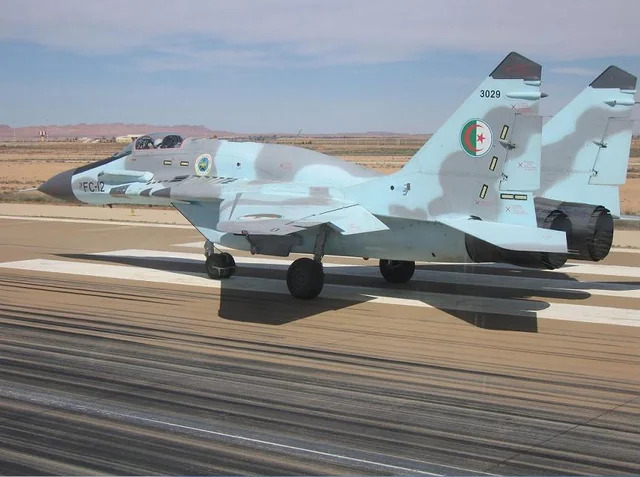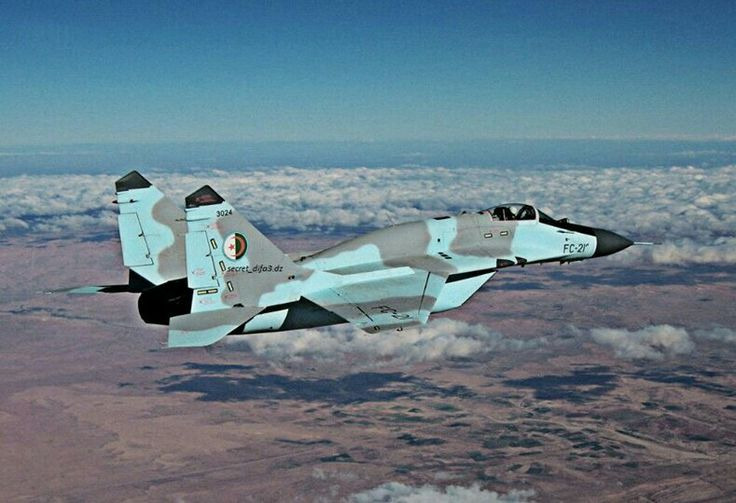- Yes, as a tech tree vehicle
- Yes, as a premium vehicle
- Yes, as an event vehicle
- Yes, as a squadron vehicle
- No, I would not like to see the MiG-29UPG in game.

Introduction
Click here to reveal
The IAF has been a relatively enthusiastic operator of the high-powered MiG-29, fielding it since 1987. As it’s coming up on 40 years of service, it’s not surprising that the MiG-29 would eventually be slated for an upgrade program to extend its utility into the 21st century. To that end, India collaborated with Mikoyan to create the MiG-29 izdeliye 9-20, otherwise known as the MiG-29UPG. If you think it looks like a MiG-29SMT (izdeliye 9-19), you’re right - the upgrade used the MiG-29SMT as a base. However, it’s not identical. A mix of indigenous and foreign electronic warfare upgrades gives the aircraft added protection against modern threats, and the weapons systems are improved too.
As the Tejas Mk.2 program is still in development, the MiG-29UPG provides India with an essential air defense fighter to defend its skies until 2035. Based on the scope of its upgrades, the MiG-29UPG should have no trouble doing so. While not fielded in large numbers, the aircraft has the range, performance, weaponry and avionics needed to perform its duties. Improved air-to-ground capability provides the cherry on top for a versatile plane that can take on any role needed.
TL;DR
- Supersonic multirole jet fighter updated to compete in the modern age
- Wide array of Russian air-to-air missiles with HMS integration
- Advanced Zhuk-M2E radar and OLS-UEM IRST allow for air-to-air and air-to-ground targeting
- TV-guided missiles and bombs for precision ground strikes
- Updated RWR and EW suite provides top-class protection
- Large internal fuel tank gives good combat range
- RD-33 Series 3 engines somewhat offset the large weight increase
- Decent countermeasures count, but may be a little low for top tier
- Not as maneuverable as the base MiG-29
Why it should be in the game: The MiG-29UPG would give India an upgraded Russian airframe that would sit nicely at a lower BR than the more famous and more powerful Su-30MKI. As a crucial element of India’s current air forces, and an upgrade of the first foreign order of MiG-29s in the world, the MiG-29UPG is a historically significant aircraft. Considering how game features are right now, this would basically be a slightly better MiG-29SMT but in the British tech tree if it were added at the time of writing. IAF representation is limited in the game right now, so a similar to existing plane is a good way to go about expanding their presence. However, if ECM features are ever expanded upon, this aircraft will get a real chance to shine as a truly unique entry in the MiG-29 lineage.
History
Click here to reveal
The history of the ‘Baaz’ starts, of course, with the history of the MiG-29. To make a long (and well-documented) story short, the MiG-29 was OKB MiG’s answer to the need for an upcoming fourth generation jet fighter. Both the United States and USSR were conceptualizing this new breed of air superiority fighter around the same time, with the MiG-29 beginning preliminary development in 1970 and the first of fourteen flight test prototypes leaving the factory floor in 1977. Full scale production was under way by 1982. NATO took notice, giving the plane the name “Fulcrum”, and with MiG-29s being exported to Warsaw Pact nations, it was only a matter of time before other export customers would become interested.
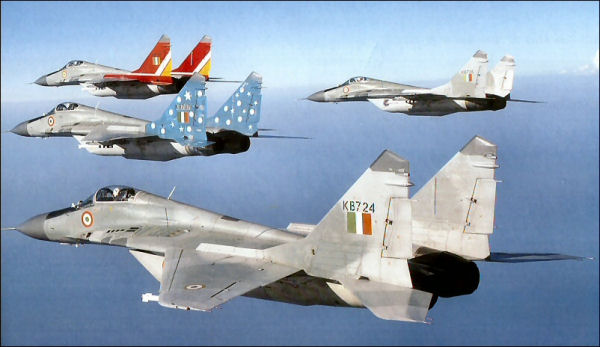
India bears the distinction of being the first nation outside the USSR and its satellite states to operate the MiG-29. With India already operating USSR aircraft, there was a good business relationship between the two countries, which helped secure the first export order for MiG-29s. Specifically, India wanted a fighter that could stand up to U.S.-made F-16s that were delivered to Pakistan. Just five years after full scale production had begun in the Soviet Union, in 1987 India had assembled its first knocked-down MiG-29. The results were satisfactory, and India would procure around 70 single seat MiG-29s (9-12B) along with eight twin-seat training aircraft over the next decade. The last ten MiG-29s to be delivered would be izdeliye 9-13s with improvements compared to the 9-12s. With their agility and long reach, they were recognized as true hunters of the sky and given the popular name ‘Baaz’, meaning “bird of prey”. It wouldn’t be long before the aircraft got their first taste of combat in the 1999 Kargil War, where they provided fighter escort to the IAF’s Mirage 2000Hs which were being used primarily as precision attack platforms. The MiG-29s never had to engage enemy aircraft, but they provided a crucial deterrent against fighters who would otherwise hamper the ground support operations cited as essential to India’s victory in the conflict.
After the war (and even a little before it) the IAF was investigating potential upgrade options for the MiG-29. Russia offered an upgrade to MiG-29SM standard while HAL envisioned something different. After the Indian Navy’s adoption of the MiG-29K in 2004, it was natural that discussion of upgrades for the existing land-based MiG-29 fleet would resume. In the end, the MiG-29UPG would be developed based on Russian experience creating the MiG-29SMT and would inherit many similar features. However, the IAF designed and implemented indigenous and third-party avionics to enhance the aircraft even further than the SMT standard did. The MiG-29UPG featured an indigenously developed electronic warfare suite aimed at commonality with other systems being used to upgrade MiG-21 and Jaguar aircraft, including a digital RWR, active jamming technology and active countermeasures - while retaining the BVP-30-26Ms of the base MiG-29, an additional 60 charges were installed with two packs of fifteen beneath each wing, giving a total of 120. A metal cover is bolted on when the BVP-30-26Ms are not in use, which can be seen on some MiG-29SMT examples. In addition the ELT-568 jamming pod was installed in the starboard tail fin. The offensive capability of the aircraft was improved with the new weapons of the MiG-29SMT such as the R-73 and R-77, as well as a further enhanced Zhuk-M2E radar. This radar is similar to the Zhuk-M of the MiG-29SMT, but includes additional modes for terrain mapping and air-to-ground tracking. The OLS-UEM IRST unit, found on the MiG-35, was also included, enabling high resolution IR tracking for the plane’s weapons. Data is fed to the pilot through the HMS system and digital MFDs in the cockpit, replacing the older electronics of the base MiG-29. To partially make up for the increased weight of the plane, new RD-33 Series 3M engines were installed. These engines have more thrust and are more reliable than the base RD-33.

Despite some teething problems with the D-29 EW suite, the first MiG-29UPG was considered fully ready by 2015. Work began on refitting the entire MiG-29 fleet (numbering around 66 due to attrition) which continued through the next several years into the 2020’s. The MiG-29UPG has not yet seen combat, but it was deployed as a deterrent amid tensions with China in 2020. Its high power and relatively light weight compared to the IAF’s heavier Su-30MKI means that while the MiG-29UPG doesn’t carry as many different kinds of weapons as the former (and with less hardpoints), it fills an invaluable role in defending India’s airspace. High altitude performance has been a major concern with India’s aircraft design for a while due to its unique terrain. Since the Tejas Mk.2 which is meant to fill the MiG-29UPG’s current role is slated for 2035, the IAF has been investigating further upgrades to the MiG-29UPG to keep it relevant. Proposed changes include switching to the RD-33MK engines used by the MiG-29K which have an even higher thrust than the RD-33 Series 3M, as well as fitting the MiG-29UPG with standoff weapons such as the indigenous HSLD Mk.II and Israeli Rampage missile. There was also intent to procure additional MiG-29 airframes to upgrade, but sanctions have prevented the transfer for a few years now. Whatever the future holds, the MiG-29UPG should be well prepared for it until it can be retired. Once it’s phased out, the MiG-29 will have had over 40 years of service with the IAF, marking four decades of excellence from home and abroad.
Specifications
Click here to reveal
Mikoyan-Gurevich MiG-29UPG
Dimensions:
- Span: 11.36 m (37 ft 3 in)
- Length: 17.32 m (56 ft 10 in)
- Height: 4.73 m (15 ft 6 in)
Weight:1
- ~11,700 kg (25,794 lb) empty
- ~16,400 kg (36,156 lb) full fuel
- ~20,400 kg (46,077 lb) MTOW
Propulsion:
- 2 x Klimov RD-33 Series 3M low-bypass turbofan2
- 3,920 kgf (8,642 lbf) static thrust each dry; 7,240 kgf (17,284 lbf) total
- 6,816 kgf (15,027 lbf) static thrust each wet; 13,632 kgf (30,053 lbf) total
- 5,430 kgf (11,971 lbf) optimal thrust each dry; 10,860 kgf (23,942 lbf) total
- 12,445 kgf (27,437 lbf) optimal thrust each wet; 24,890 kgf (54,873 lbf) total
Maximum speed:
- 1,500 km/h (932 mph) at sea level
- 2,450 km/h (1,522 mph) at high altitude
Service ceiling: 18,000 m (59,055 ft)
Basic specs notes:
- The weight is based off of the given weight of the MiG-29SMT in War Thunder with a slight increase due to extra avionics.
- The given thrust is based off of War Thunder where the thrust of the RD-33 at low speed is less than the typical given value due to either intake shields being active or uneven airflow caused by the auxiliary intakes. Either way the engine gets less airflow than it would need to hit 8,000 kgf static on afterburner.
Armament:3
- Guns:
- 1 x GSh-30-1 30 mm autocannon (150 rounds)
- Air-to-air missiles:
- Up to 4 x R-27R semi-active radar homing air-to-air missile
- Up to 4 x R-27T IR-homing air-to-air missile
- Up to 2 x R-27ER semi-active radar homing air-to-air missile
- Up to 2 x R-27ET IR-homing air-to-air missile
- Up to 6 x R-73 IR-homing air-to-air missile
- Up to 6 x R-77 active radar homing air-to-air missile
- Bombs:
- Up to 16 x 100 kg OFAB-100 fragmentation bomb
- Up to 8 x 250 kg FAB-250M-62 low-drag general-purpose bomb
- Up to 8 x 250 kg OFAB-250Sh parachute-retarded fragmentation bomb
- Up to 6 x 500 kg FAB-500M-62 low-drag general-purpose bomb
- Up to 6 x 500 kg OFAB-500Sh parachute-retarded fragmentation bomb
- Up to 4 x 500 kg ZB-500 incendiary bomb
- Guided bombs:
- Up to 4 x 500 kg KAB-500Kr-E TV-guided bomb
- Up to 4 x 500 kg KAB-500L laser-guided bomb4
- Rockets:
- Up to 80 x 80 mm S-8 rocket
- Up to 20 x 130 mm S-13 rocket
- Air-to-ground missiles:
- Up to 2 x Kh-29L laser-guided air-to-ground missile4
- Up to 2 x Kh-29TE TV-guided air-to-ground missile
- Up to 2 x Kh-29TD IR-guided air-to-ground missile5
- Up to 2 x Kh-31P anti-radiation homing missile
- Anti-ship missiles:
- Up to 2 x Kh-31A active radar homing missile
- Up to 2 x Kh-35UE active radar homing missile
- Drop tanks:
- Up to 1 x 2,000 liter (528 U.S. gallon) drop tank
- Up to 2 x 1,100 liter (291 U.S. gallon) drop tank
Armament notes:
- Armaments were generally taken from MiG-29SMT loadouts in War Thunder as well as other sources for those weapons not seen mounted in game.
- As far as I’m aware, the MiG-29UPG has not been integrated with any targeting pods, so it can’t self designate. I included the laser guided weapons for completeness.
- I am unsure whether India has procured the Kh-29TD variant. I included it because the MiG-29SMT can use it.
Crew: 1
Additional equipment:
- FGM229 Zhuk-M2E multi-mode slotted array pulse doppler radar
- OLS-UEM infrared search and track unit
- D-29 electronic warfare suite
- Digital RWR
- Coverage: 1 - 18 GHz (D band to high J band)
- 360 degree threat detection
- Active Phased Array jamming antennae
- Elettronica SpA ELT-568 integrated jamming pod
- Coverage: E - J band
- ELTA ELL-8251 suspended jamming pod
- Countermeasures dispensers:
- 2 x BVP-30-26M countermeasures dispenser, one in each tail fin strake (30 charges each, 60 total countermeasures)
- 4 x Bharat Dynamics countermeasures dispenser, two under each wing (15 charges each, 60 total countermeasures)
- HMS
- Digital MFDs
- Ballistic computer: bombs, rockets and guns (CCIP/RP)
- IFR probe
- Ejection seat
Gallery
Click here to reveal

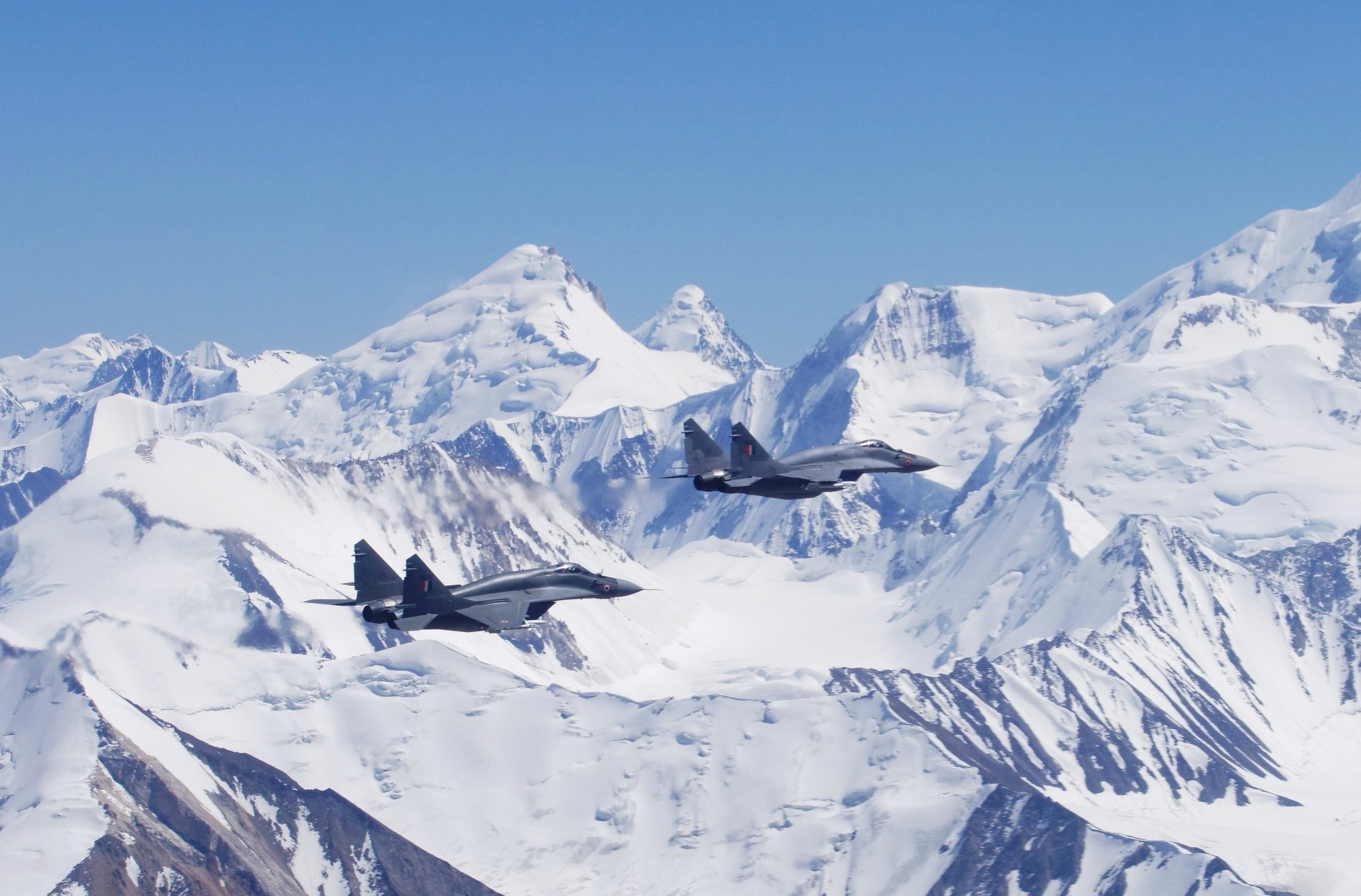


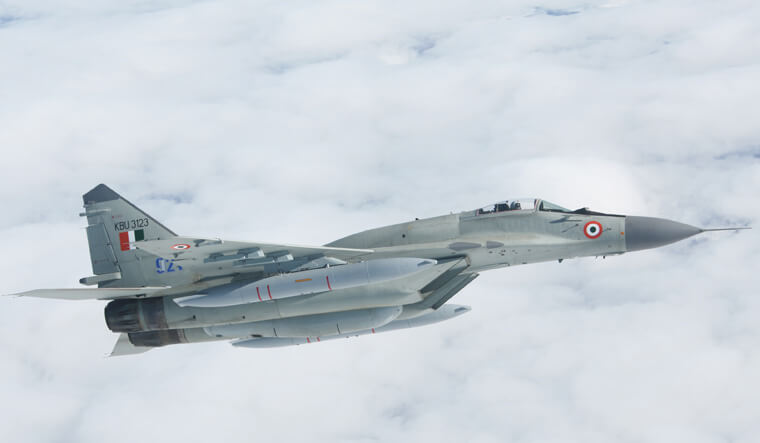

Sources:
- Famous Russian Aircraft: Mikoyan MiG-29 by Yefim Gordon (2006)
- Mig-29 UPG: Dragonslayers of IAF deployed in Srinagar – Indian Defense Analysis
- IAF’s MiG-29UPG Fleet to Get a Boost: New Engines and Second Life Extension – Indian Defence Research Wing
- https://archive.ph/20130504123535/http://en.take-off.ru/news/102-feb2011/558-mig-29upg-india-02-2011
- https://www.sps-aviation.com/story/?id=2670&h=Upgraded-IAF-MiG-29s-SPAR-with-Omani-F-16s
- MAKS 2021: Upgrade of Indian Air Force MiG-29 fighters to MiG-29UPG will be completed in 2022
- TRISHUL: IAF's MiG-29UPG Upgrade Package Detailed
- https://www.key.aero/article/fulcrum-through-decades
- Tejas Mk.1 & Mk.1A: News & Discussions: 23 February 2019 - Page 38 - Bharat Rakshak
- MiG-29SMT
- TRISHUL: April 2019
- First Look at Rampage Air-to-Ground Weapon on Indian Navy’s MiG-29K – Indian Defence Research Wing
- Amid LCA MK-2, MMRCA & AMCA Delays, Indian Air Force To Augment, Upgrade Its MiG-29 Fighter Fleet

